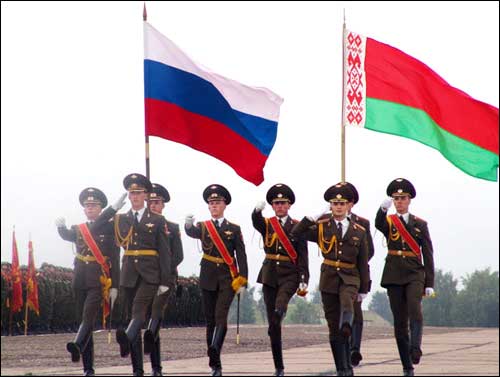
Ten Years of Anti-NATO Exercises by Russian and Belarusian Armed Forces
Publication: Eurasia Daily Monitor Volume: 6 Issue: 178
By:

On September 26 the official publication of the Russian ministry of defense Krasnaya Zvezda announced the beginning of the second phase of Zapad 2009 (West 2009), a large-scale combined arms exercise conducted in Belarus. This phase of the exercise lasted from September 26-29 and involved more than 12,500 troops, over 100 aircraft and helicopters, 4,000 pieces of military equipment including tanks, armored personnel carriers, self-propelled artillery, tube artillery, self-propelled multi-rocket launchers, and ground-based SAM systems. The focus of the second phase of the exercise, according to Krasnaya Zvezda, was on air defense operations (Krasnaya Zvezda, September 26). The air defense activities involved the interception of enemy aircraft, and the firing of S-200 air defense missiles at the Telemba Range in Chita Oblast. The exercise also witnessed Russian Special Forces operating in conjunction with Belorussian territorial troops against invading forces.
On September 28, Dmitry Litovkin, a prominent defense journalist, published a long article on Zapad 2009 under the title: "The Exercises Got Caught in the Net." Litovkin’s play-on-words referred to the fact that this exercise was to be a test of the new brigade-centric organization of the ground forces and would involve the implementation of the concept "network-centric warfare," which the author described as a U.S. concept associated with "the large-scale use of electronic reconnaissance and target acquisition (satellite, unmanned aerial vehicles, etc.) and the use of cellular groupings that can move quickly around the theater of military operations and attack the enemy’s flanks or rear" (Izvestia, September 28).
Litovkin described Zapad 2009 as an exercise designed to counter the specific threat faced by Russia and Belarus in their western strategic direction, which he differentiated from those in the eastern and southern strategic directions. In the western strategic direction Russian forces will face "innovative armies employing the forms and means of non-contact warfare involving the latest forces and means." This unnamed opponent is clearly NATO. In fact, Litovkin speaks of Russian forces confronting "an opponent armed to NATO standards in the Georgian-Russian confrontation over South Ossetia last year" (Izvestia, September 28). In the eastern strategic direction Russian forces will likely face a multi-million-man army with a traditional approach to the conduct of combat: linear deployments with large concentrations of manpower and fire power on different axis. In the southern strategic direction Russian forces expect to confront irregular forces and sabotage groups fighting a partisan war against "the organs of Federal authority," i.e., internal troops. the border patrol, and the FSB.
In the course of the preparations for Zapad 2009 the Russian armed forces moved by rail and air a considerable combined armed force into Belarus in the course of five days. The units deployed included: a battalion from the 51st Regiment of the Airborne Forces stationed at Tula; the 15th, 21st, and 23rd Motorized Rifle Brigades of the 2nd Combined Arms Army of the Volga-Ural Military District, and a battalion from 4th Independent Tank Brigade of the Moscow Military District.
Since the first large-scale post-Cold War exercise Zapad 1999, NATO has been the explicit threat for all major exercises on the western strategic direction. What is different in Zapad 2009 is the focus on a more maneuverable high-technology force capable of rapid deployment into theater and the conduct of non-linear precision-strike warfare. Ten years ago Zapad 1999 ended with the first use of nuclear weapons to "de-escalate" a NATO-Russian conflict when a conventional defense failed. Zapad 2009 might still end in the same fashion, but the conventional phase in this case has been extended, and involves a shift towards network-centric warfare and precision-strike systems in a counter-attack against the "aggressors."
Critical assessments of Zapad 2009 and the simultaneous Ladoga 2009 conducted by Russian forces alone will provide good indicators regarding the direction and success of Russian military transformation, especially the level of training of the force and its capacity to integrate new technology. After what Aleksandr Goltz characterized as "the eleven lost years" of military reform in 2004, the Russian General Staff, on the basis of combat experience in Georgia, seems intent on organizational reform -specifically the shift from a division-based ground force, to one based on 85 maneuver brigades, and upon technological rearmament to reflect the requirements for the informatization of warfare and the conduct of non-linear, non-contact operations.
One key innovation with long-term consequences is the decision to purchase advanced weapons abroad, including over a dozen UAV’s from Israel. Deputy Defense Minister Vladimir Popovkin in a recent interview in Krasnaya Zvezda spoke of accelerated weapons procurement in 2009 and noted increased acquisitions of aircraft, helicopters, tanks, and other armored systems. He also emphasized the need to modernize the strategic nuclear forces, begin the mass production of precision strike weapons including the short-range ballistic missile, the Iskander, precision munitions for the Grad and Smerch Multiple Launch Rocket Systems, and the development of improved digital maps and global positioning technology based on GLONASS. He noted that it would take 3 to 5 years to train the crews to use such systems and to integrate them into military doctrine (Krasnaya Zvezda, September 23).
President Dmitry Medvedev, speaking in Kaliningrad during a visit to the exercises on September 28, described them as a threat to no one: "I would like to point out that the aim of our exercise is of a defensive nature. We are not threatening anyone" (RIA Novosti, September 28). However, the Polish defense ministry noted the scale of the maneuvers, their location in Kaliningrad Oblast and Belarus, and the scenario of an attack from the west. Its spokesman said that the defense ministry would monitor the exercises carefully and expressed surprise at the scenario, given the fact that Poland and NATO have no aggressive intent.




